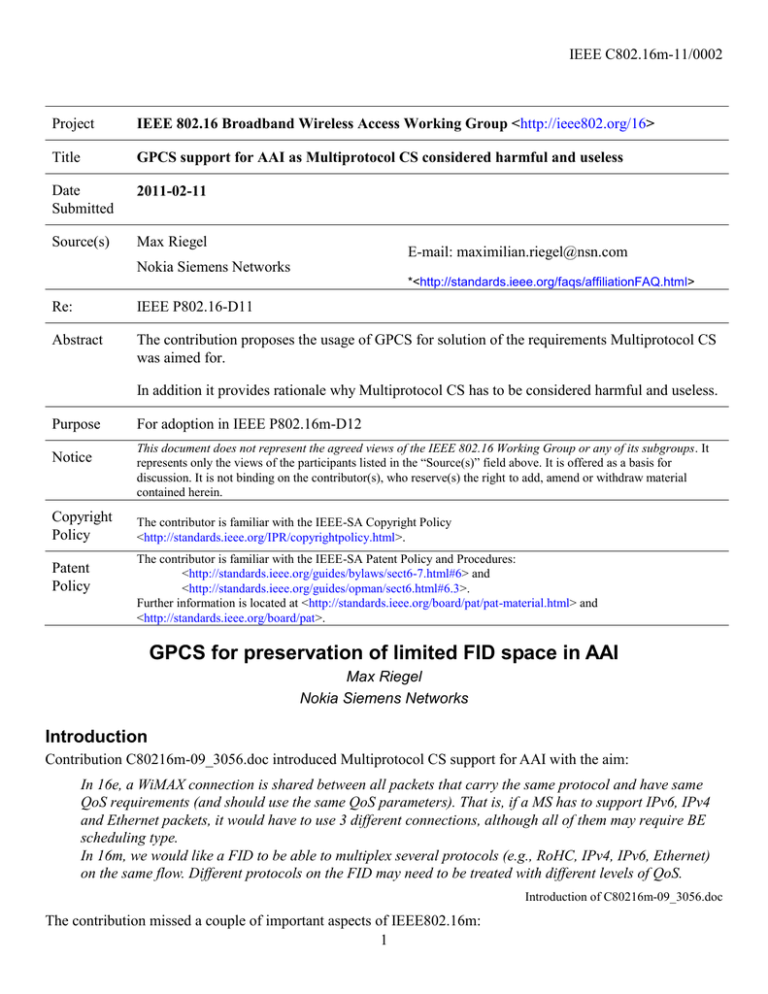IEEE C802.16m-11/0002 Project Title
advertisement

IEEE C802.16m-11/0002 Project IEEE 802.16 Broadband Wireless Access Working Group <http://ieee802.org/16> Title GPCS support for AAI as Multiprotocol CS considered harmful and useless Date Submitted 2011-02-11 Source(s) Max Riegel E-mail: maximilian.riegel@nsn.com Nokia Siemens Networks *<http://standards.ieee.org/faqs/affiliationFAQ.html> Re: IEEE P802.16-D11 Abstract The contribution proposes the usage of GPCS for solution of the requirements Multiprotocol CS was aimed for. In addition it provides rationale why Multiprotocol CS has to be considered harmful and useless. Purpose Notice Copyright Policy Patent Policy For adoption in IEEE P802.16m-D12 This document does not represent the agreed views of the IEEE 802.16 Working Group or any of its subgroups. It represents only the views of the participants listed in the “Source(s)” field above. It is offered as a basis for discussion. It is not binding on the contributor(s), who reserve(s) the right to add, amend or withdraw material contained herein. The contributor is familiar with the IEEE-SA Copyright Policy <http://standards.ieee.org/IPR/copyrightpolicy.html>. The contributor is familiar with the IEEE-SA Patent Policy and Procedures: <http://standards.ieee.org/guides/bylaws/sect6-7.html#6> and <http://standards.ieee.org/guides/opman/sect6.html#6.3>. Further information is located at <http://standards.ieee.org/board/pat/pat-material.html> and <http://standards.ieee.org/board/pat>. GPCS for preservation of limited FID space in AAI Max Riegel Nokia Siemens Networks Introduction Contribution C80216m-09_3056.doc introduced Multiprotocol CS support for AAI with the aim: In 16e, a WiMAX connection is shared between all packets that carry the same protocol and have same QoS requirements (and should use the same QoS parameters). That is, if a MS has to support IPv6, IPv4 and Ethernet packets, it would have to use 3 different connections, although all of them may require BE scheduling type. In 16m, we would like a FID to be able to multiplex several protocols (e.g., RoHC, IPv4, IPv6, Ethernet) on the same flow. Different protocols on the FID may need to be treated with different levels of QoS. Introduction of C80216m-09_3056.doc The contribution missed a couple of important aspects of IEEE802.16m: 1 IEEE C802.16m-11/0002 A CS type already exists which is capable to transport IPv4 packets, IPv6 packets and ROHC packets over the same service flow: ‘Packet, IP’ (CS Type 14) The packets can be distinguished by the 4-bit IP-version field in the IP header. ROHC is able to generate packets which never show 0x4 nor 0x6 in this bitfield to enable multiplexing of compressed and uncompressed payload on the same link. To comply with RFC4840, Mobile WiMAX is designed that a AMS either deploys IP-CS or deploys ETHCS, but never both on the same AMS (prevented by design of the network). Therefore the possibility to multiplex plain IP packets and Ethernet frames on the same link between an AMS and ABS never occurs in Mobile WiMAX. Multiprotocol CS tries to solve issues which do not exist. It can be considered as completely useless. Moreover it introduces multiple encapsulation methods on the same link, which contradicts to the guidance, which the IETF IAB provided in the RFC4840 ‘Multiple Encapsulation Methods Considered Harmful’ to the IEEE P802.16 for the design of convergence sub-layers. Therefore the Multiprotocol CS has also to be considered as harmful not only for the operation of IEEE802.16m but also for the reputation of the IEEE802.16 WG. Shortage of FID space in AAI During the discussion about the removal of the Multiprotocol CS often the need of it for preservation of FIDs was mentioned as reason to keep it in the specification. As shown above, Multiprotocol CS is not able to preserve any FIDs beyond what is available with ‘Packet, IP CS’. Nevertheless some configuration may exist, which suffer from the limitations to 4-bit for FID encoding. Limitations mainly occur when multiple end-users have to be served over a single radio link, e.g. a CPE containing a multiplexing/demultiplexing function to serve a higher number of customers over the same ABSAMS connection. If plain routing is not sufficient, e.g. due to overlapping IP address spaces of different customers served over the same CPE, layer 2 separation of IP networks by protocols like VLAN or MPLS are deployed. IEEE802.16m is currently limited to a single layer of VLAN support according to IEEE802.1Q but misses completely support for MPLS, Provider Bridging (802.1ad) or Provider Backbone Bridging (802.1ah), which are usually deployed in such scenarios. GPCS support for AAI By its GPCS IEEE802.16-2009 supports MPLS and Ethernet with support of 802.1ad and 802.1ah. To enable AAI for deployments which would suffer from the 4-bit FID space, it is proposed to introduce GPCS support in 802.16m. Luckily the modification to the technical specification are only minor (see below): 5.3 Generic Packet Convergence Sublayer (GPCS) The Generic Packet CS (GPCS) is an upper layer protocol-independent packet convergence sublayer that supports multiple protocols over an IEEE 802.16 air interface. It is defined as follows: — GPCS provides a generic packet convergence layer. This layer uses the MAC SAP and exposes a SAP to GPCS applications. — GPCS does not re-define or replace other convergence sublayers. Instead, it provides a SAP that is not protocol specific. 2 IEEE C802.16m-11/0002 — With GPCS, packet parsing happens “above” GPCS. The results of packet parsing are classification parameters given to the GPCS SAP for “parameterized classification,” but upper layer packet parsing is left to the GPCS application. — With GPCS, the upper layer protocol that is immediately above the IEEE 802.16 GPCS is identified by a TLV parameter, GPCS protocol type, as defined in 11.13.19.5.1. The GPCS protocol type shall be included in C-SFM primitives and AAI-DSx/DSx messages during connection establishment. — GPCS defines a set of SAP parameters as the result of upper layer packet parsing. These are passed from upper layer to the GPCS in addition to the data packet. The SAP parameters include SFID, MS MAC Address, data, and length. Each is defined in 5.3.3. — GPCS allows multiplexing of multiple layer protocol types (e.g., IP, Ethernet, MPLS) over the same IEEE 802.16 connection. An appropriate upper protocol layer that supports protocol multiplexing is used to do this, and it is signaled in the GPCS_PROTOCOL_TYPE TLV in AAIDSx/DSx messages to indicate that multiple protocols are supported for a connection/service flow. It is outside the scope of the GPCS to specify how the upper layer multiplexes and demultiplexes multiple protocol data packets over an IEEE 802.16 connection/service flow. — For interoperability, upper layer protocol type may need an interface specification. Such a standard specification is out of scope of this document. — With GPCS, the IEEE 802.1D bridging will be supported transparently by the IEEE 802.16 air interface, because the GPCS requires the upper layer to provide the MS MAC Address and SFID with every packet, where the MS MAC Address and SFID can represent a port and a port is either a unicast port or broadcast port. — PHS as defined in 5.2.3 defines rules for how packets with suppressed fields are reconstructed based on the PHSI and the associated PHS rule. This reconstruction method can also be applied on packets transferred over the GPCS. Details are given in 5.3.6. 5.3.1 Mapping of the GPCS service to upper layers In the case where a GPCS instance services only a single GPCS peer on an AMS/SS, the MS MAC Address field of the GPCS_DATA primitive shall be constant and set to the MAC address of the AMS/SS. The SFID field of the GPCS_DATA primitive shall be set to the SFID of the service flow being carried. In the case where a GPCS instance services more than one AMS/SS, the MS MAC Address field of the 3 IEEE C802.16m-11/0002 GPCS_DATA primitive will indicate the AMS/SS that is the source or destination for the PDU. The SFID field of the GPCS_DATA primitive shall be set to the SFID of the service flow being carried. 5.3.2 Operation of GPCS with SSs that do not support the GPCS An ABS/BS that supports GPCS may interoperate with an AMS/SS that does not support GPCS. It can be observed that a GPCS service with GPCS_PROTOCOL_TYPE 0x0000 (Ethernet MAC Service) carries packets formatted identically to the packets used in the IEEE 802.3 specific part of the Packet CS. Also, a GPCS service with GPCS_PROTOCOL_TYPE 0x0003 (Raw IP) carries packets formatted identically to the packets used in the IP specific part of the Packet CS. An ABS/ BS may operate using GPCS at the base station, locally using GPCS_PROTOCOL_TYPE=0x0000, while signaling to the AMS/SS during connection setup that the IEEE 802.3 specific part of the packet CS is being used. An ABS/ BS may operate using GPCS at the base station, locally using GPCS_PROTOCOL_TYPE=0x0003, while signaling to the AMS/SS during connection setup that the IP specific part of the packet CS is being used. 5.3.3 GPCS SAP parameters The GPCS uses the GPCS SAP, an instance of the logical CS SAP. The GPCS SAP parameters enable the upper layer protocols to generically pass information to the GPCS so that the GPCS does not need to interpret upper layer protocol headers in order to map the upper layer data packets into proper IEEE 802.16 MAC connections. Since the SAP parameters are explicit, the parsing portion of the classification process is the responsibility of the upper layer. The parameters are relevant for SAP data path primitives, GPCS_DATA.request and GPCS_DATA.indication as described in 5.3.4 and 5.3.5, respectively. Service flow ID (SFID) Unique identifier to identify a unidirectional service flow for an MS. A GPCS implementation shall map the combination of SFID and MS MAC Address directly to a MAC connection ID. During connection / service flow establishment, the 802.16 control plane function shall provide GPCS the mapping information. MS MAC Address: 48-bit unique identifier used by MS. DATA: The payload delivered by the GPCS upper layer to the GPCS, or by the GPCS to the upper layer. LENGTH: Number of bytes in DATA. 5.3.4 GPCS_DATA.request 5.3.4.1 Function This primitive defines the transfer of data from the upper layer to the GPCS. 5.3.4.2 Semantics of the service primitive The parameters of the primitive are as follows: GPCS_DATA.request ( SFID, MS MAC Address, length, data ) The parameters SFID, MS MAC Address, length, and data are described in 5.3.3. 5.3.4.3 When generated This primitive is generated by an upper layer protocol when a GPCS SDU is to be transferred to a peer entity or entities. 5.3.4.4 Effect of receipt The receipt of this primitive causes GPCS to map the SFID and MS MAC Address to a unidirectional service flow, and thereby a connection. GPCS invokes MAC functions, for example the MAC SAP (an example MAC SAP definition is provided in Annex C of IEEE802.16-2009) to effect transfer of the SDU to the MAC layer. 5.3.5 GPCS_DATA.indication 5.3.5.1 Function This primitive defines the transfer of data from the GPCS to an upper layer protocol. 5.3.5.2 Semantics of the service primitive The parameters of the primitive are as follows: GPCS_DATA.indication 4 IEEE C802.16m-11/0002 ( SFID, MS MAC Address, length, data ) The parameters SFID, MS MAC Address, length, and data are described in 5.3.3. Note that SFID and MS MAC Address are not transferred over the IEEE 802.16 air interface. The GPCS shall map the CID or STID+FID to SFID and MS MAC Address, and then pass them to the upper layer of the GPCS through GPCS_DATA.indication, where the CID or STID+FID is provided in MAC SAP. 5.3.5.3 When generated This primitive is generated by GPCS whenever a GPCS SDU is to be delivered to an upper layer protocol resulting from receipt of a MAC PDU. 5.3.5.4 Effect of receipt The effect of receipt of this primitive by the upper layer protocol entity is dependent on the validity and content of the SDU. 5.3.6 PHS operation PHS header suppression and reconstruction according to 5.2.3 may be deployed on particular GPCS service flows by installing PHS rules at the receiving side of the service flow using the procedures described in 5.2.3.2. 5 IEEE C802.16m-11/0002 Further changes: <<add entries for GPCS in Tables 685, 686, 734, 782 >> Table 685 Table 686 Table 734 Table 782 (p.124 l.9) (p.127 l.12) (p. 232 l.5) (p.436 l.15) 'Bit #0: GPCS' 'Bit #0: GPCS' '0: GPCS' '0: GPCS' 6








